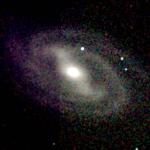Messier Index/M109
| Messier 109[1] | |
|---|---|
 Barred spiral galaxy M109 | |
| Observation data (w:J2000 epoch) | |
| Constellation | w:Ursa Major |
| Right ascension | 11h 57m 36.0s[2] |
| Declination | +53° 22′ 28″[2] |
| Type | SB(rs)bc[2], w:LINER/HII[2] |
| Apparent magnitude (V) | 10.6[2] |
| Other designations | |
| NGC 3992[2], MCG +09-20-044[2], PGC 037617[2], IRAS 11549+5339[2], UGC 6937[2] | |
Messier 109 (also known as NGC 3992) is a w:barred spiral galaxy approximately 46 million w:light-years away[1] in the w:constellation w:Ursa Major. M109 can be seen southeast of the star Phecda (γ UMa).
History
Messier 109 was discovered by w:Pierre Méchain in w:1781. In w:1783 w:Charles Messier catalogued NGC 3992 as his 109th object.
Between the 1920s through the 1950s, it was considered that Messier objects over 103 were not official, but in later years the additions became more widely accepted. w:David H. Levy mentions the modern 110 object catalog while w:Sir Patrick Moore gave the original to 104 but has M105-M109 listed as an addendum. By the late 1970s all 110 objects are commonly used among astronomers as they still are today.
General information
In March of w:1956, w:supernova 1956A was observed in M109. SN 1956A was a type Ia w:supernova in the southeast part of the galaxy, glowing at magnitude 12.8 to 12.3 at its maximum. SN 1956A was the only supernova observed in M109 since its discovery.
M109 has three w:satellite galaxies (w:UGC 6923, w:UGC 6940 and w:UGC 6969) and possibly might have more. Detailed w:hydrogen line observations have been obtained from M109 and its satellites. M109's H I distribution is regular with a low level radial extension outside the stellar disc, while at exactly the region of the bar, there is a central H I hole in the gas distribution. Possibly the gas has been transported inwards by the bar because of the emptiness of the hole no large accretion events can have happened in the recent past.[3]
Environment
M109 is the brightest galaxy in the w:M109 Group, a large w:group of galaxies located in the w:constellation Ursa Major that may contain over 50 galaxies.[4][5][6][7]
External links
- "Messier 109". SEDS. Retrieved 11 August.
{{cite web}}: Check date values in:|accessdate=(help); Italic or bold markup not allowed in:|work=(help); Unknown parameter|accessyear=ignored (|access-date=suggested) (help) - "Dark and luminous matter in the NGC 3992 group of galaxies". Astrophysics. Retrieved 19 April.
{{cite web}}: Check date values in:|accessdate=(help); Italic or bold markup not allowed in:|work=(help); Unknown parameter|accessyear=ignored (|access-date=suggested) (help) - "Dark and luminous matter in the NGC 3992 group of galaxies". ESO. Retrieved 8 April.
{{cite web}}: Check date values in:|accessdate=(help); Italic or bold markup not allowed in:|work=(help); Unknown parameter|accessyear=ignored (|access-date=suggested) (help) - M109
References
- ↑ a b Kaufmann, D.E. (1996). "Self-consistent models of barred spiral galaxies" (PDF). Astronomy & Astrophysics. EDP Sciences. 309: 381–402. ISSN 0004-6361.
{{cite journal}}: Unknown parameter|coauthors=ignored (|author=suggested) (help); Unknown parameter|month=ignored (help) - ↑ a b c d e f g h i j "NASA/IPAC Extragalactic Database". Results for M 109. Retrieved 2006-10-10.
- ↑ Bottema, Roelof (2002). "Dark and luminous matter in the NGC 3992 group of galaxies". Astrophysics. Retrieved 19 April.
{{cite web}}: Check date values in:|accessdate=(help); Italic or bold markup not allowed in:|work=(help); Unknown parameter|accessyear=ignored (|access-date=suggested) (help) - ↑ R. B. Tully (1988). Nearby Galaxies Catalog. Cambridge: Cambridge University Press. ISBN 0-521-35299-1.
- ↑ P. Fouque, E. Gourgoulhon, P. Chamaraux, G. Paturel (1992). "Groups of galaxies within 80 Mpc. II - The catalogue of groups and group members". Astronomy and Astrophysics Supplement. 93: 211–233.
{{cite journal}}: CS1 maint: multiple names: authors list (link) - ↑ A. Garcia (1993). "General study of group membership. II - Determination of nearby groups". Astronomy and Astrophysics Supplement. 100: 47–90.
- ↑ G. Giuricin, C. Marinoni, L. Ceriani, A. Pisani (2000). "Nearby Optical Galaxies: Selection of the Sample and Identification of Groups". Astrophysical Journal. 543: 178–194. doi:10.1086/317070.
{{cite journal}}: CS1 maint: multiple names: authors list (link)